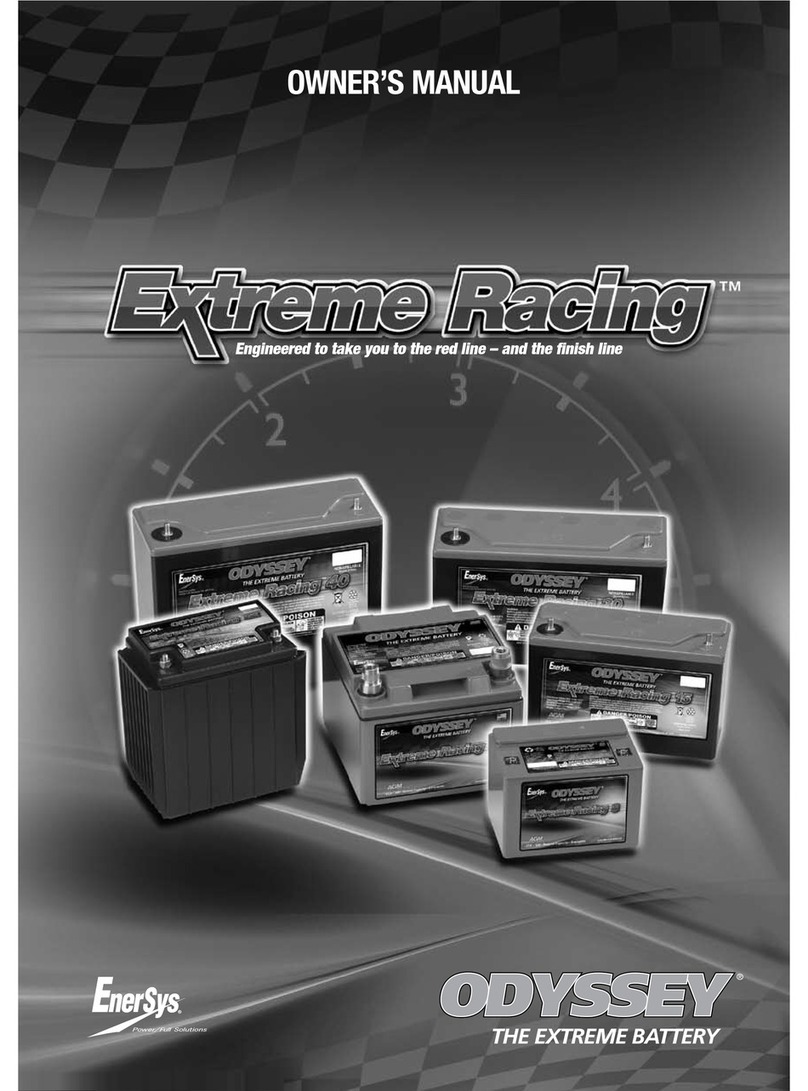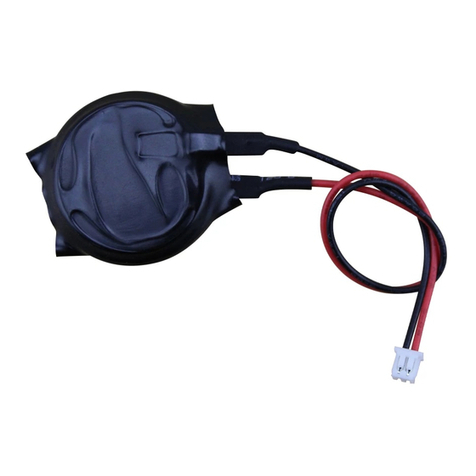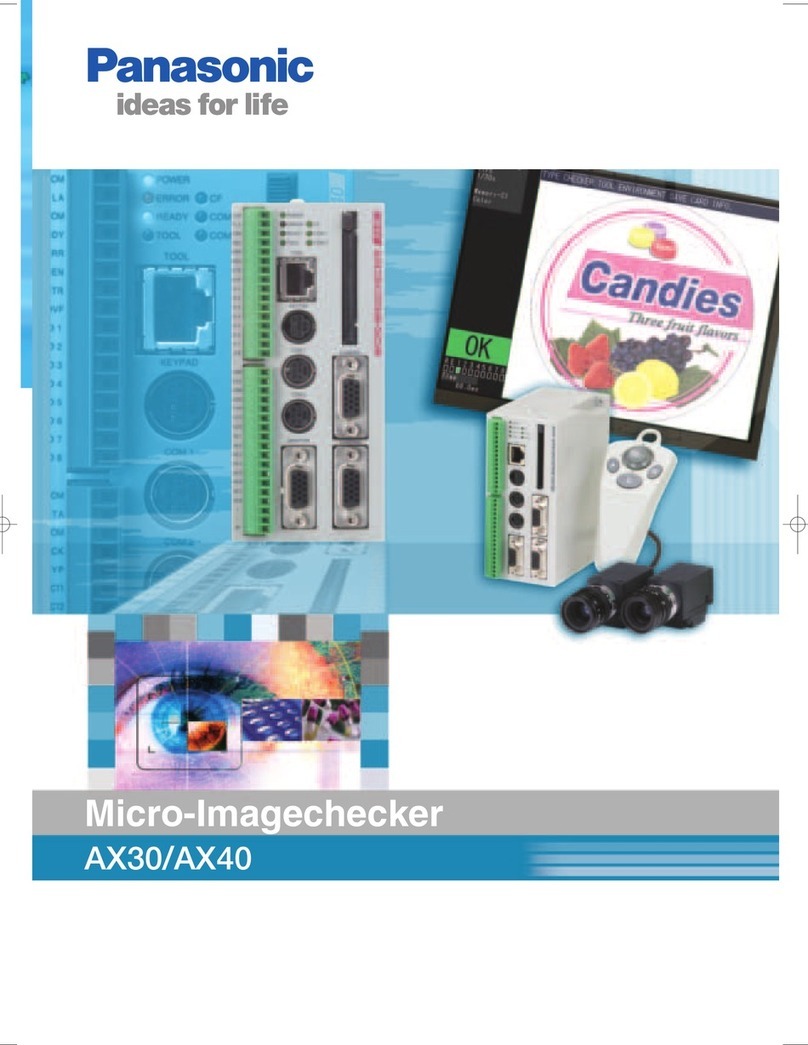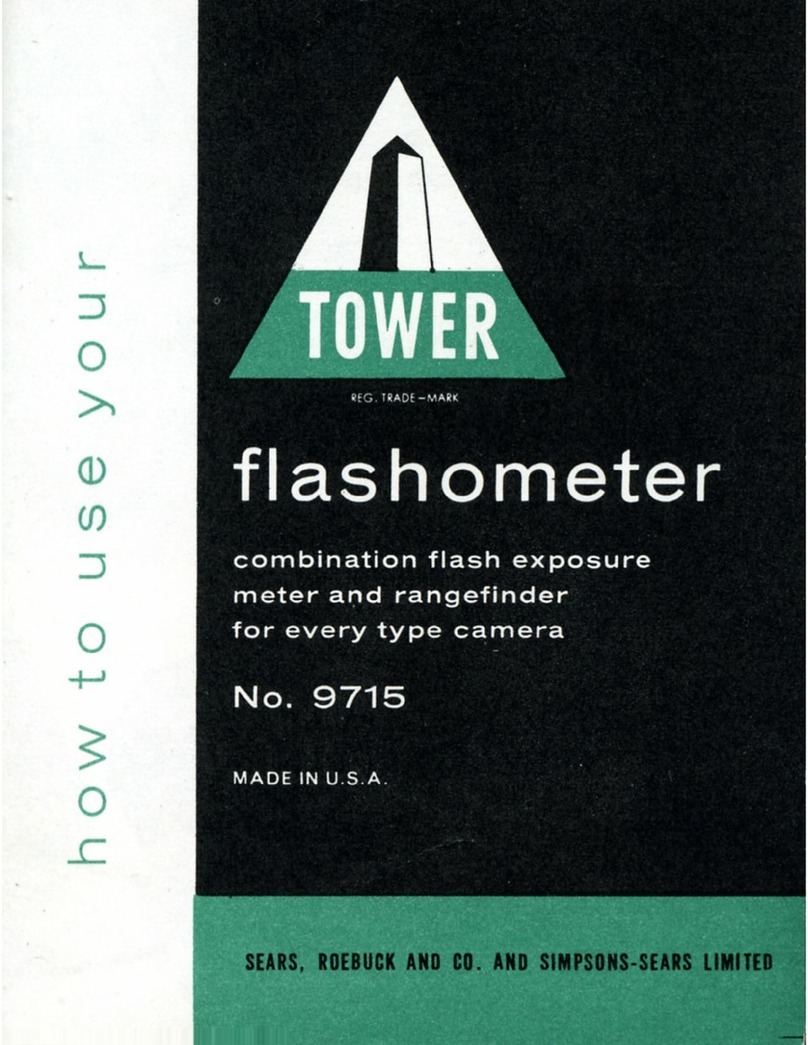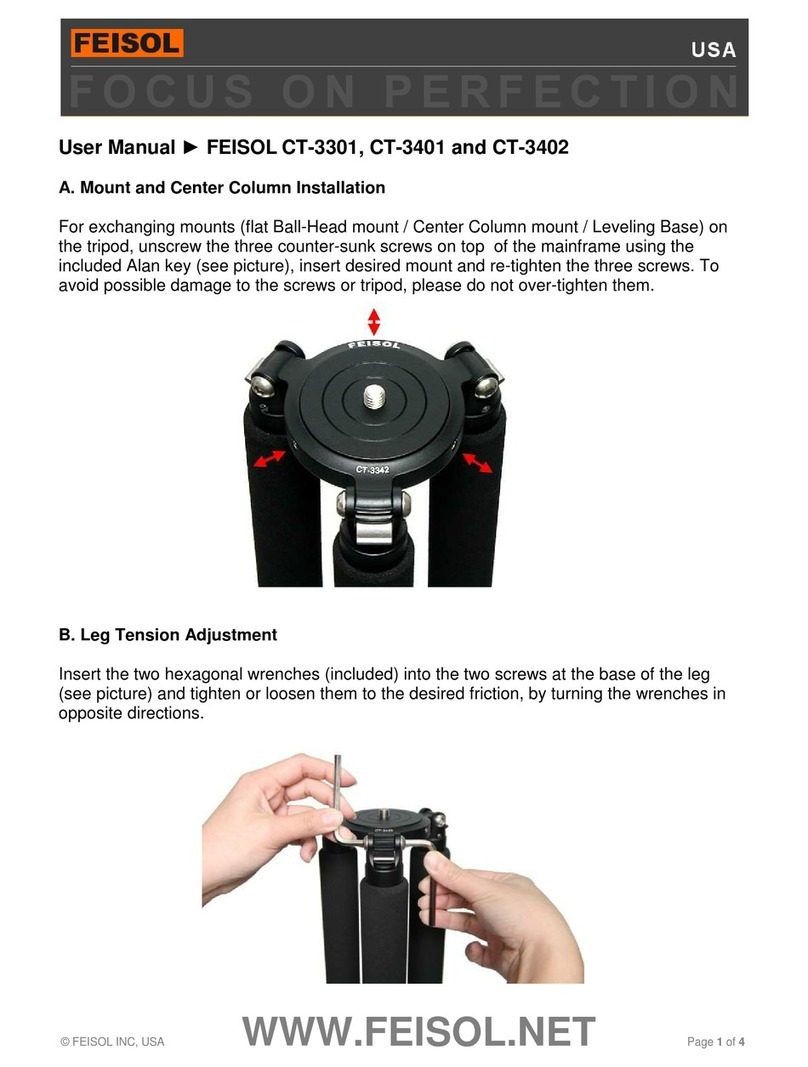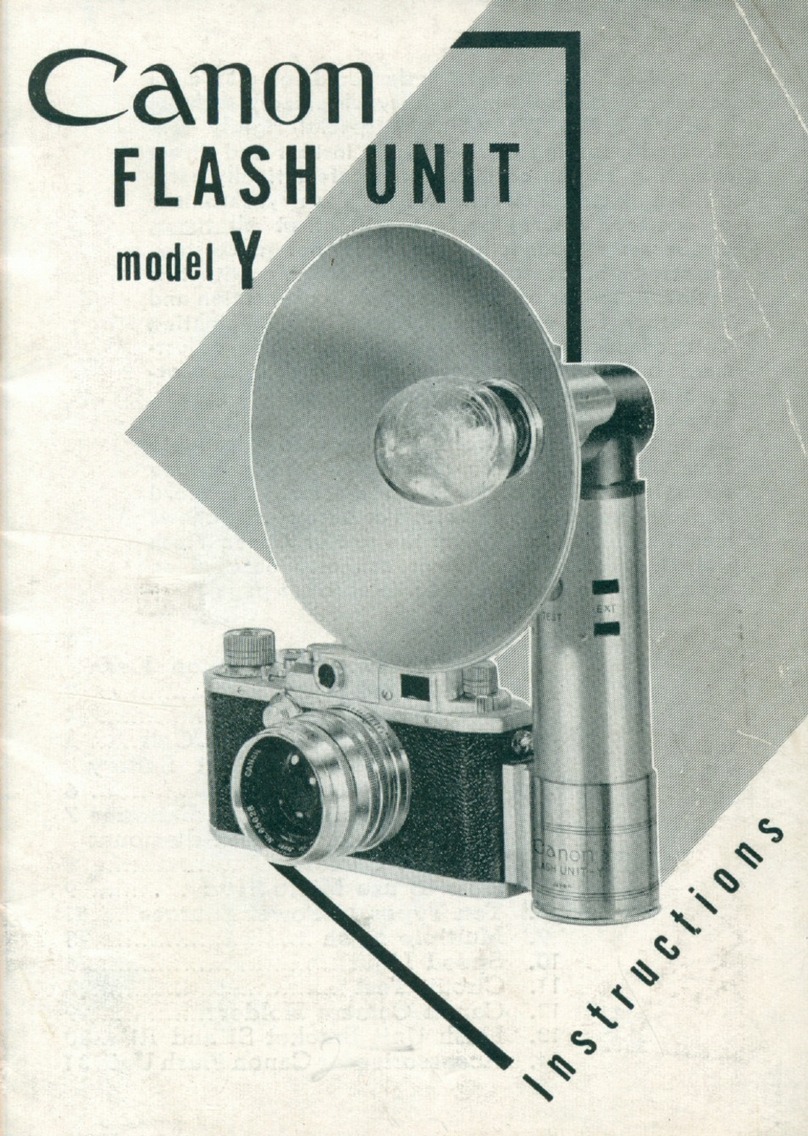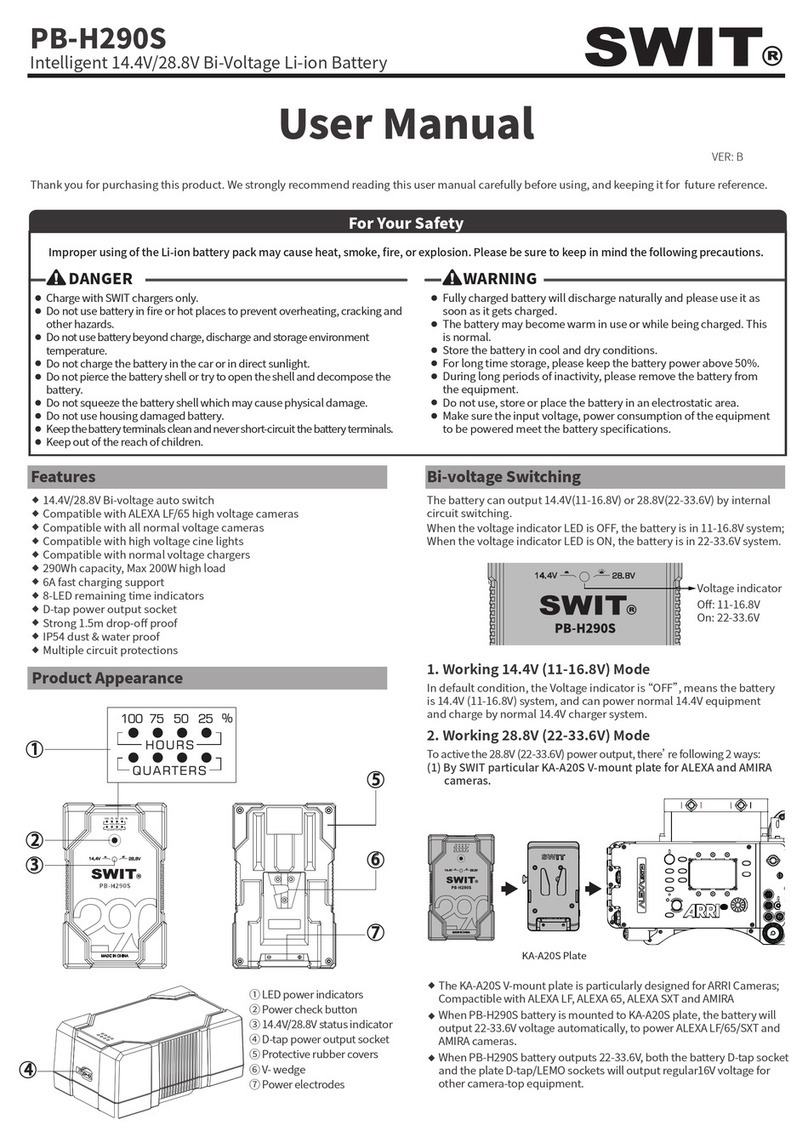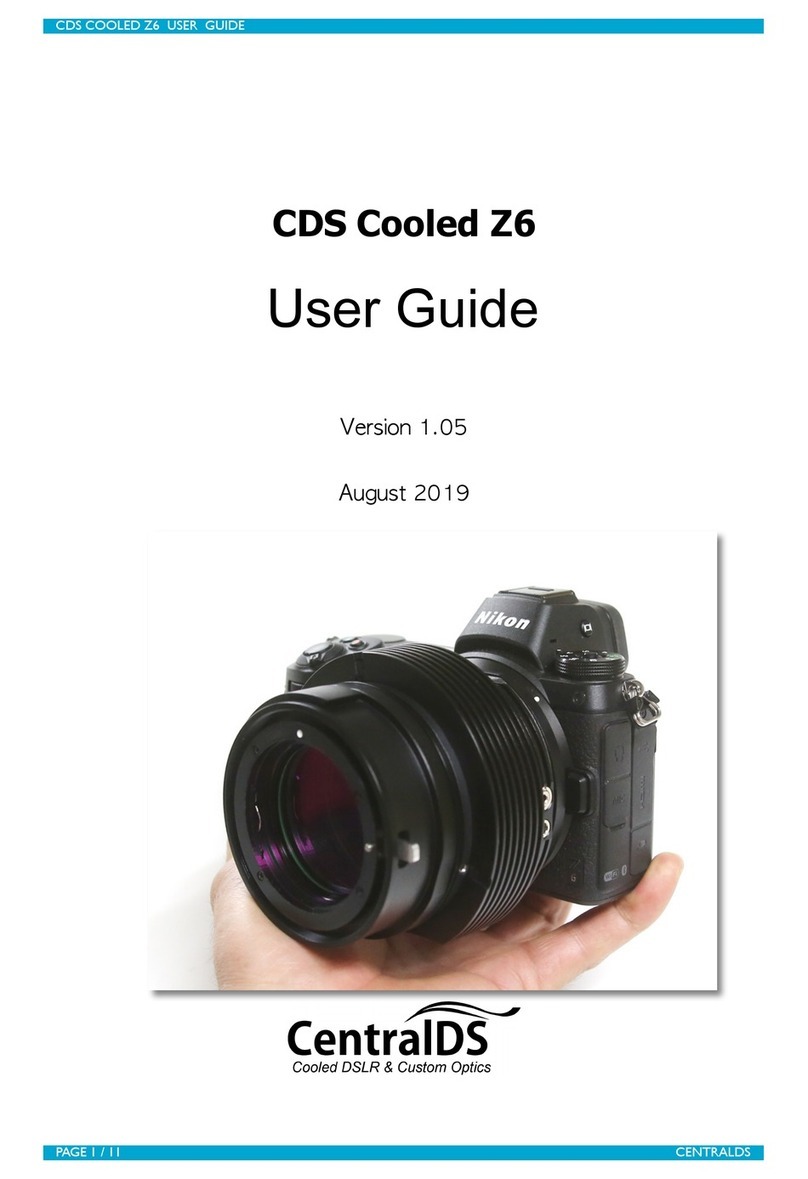genz III Series User manual

Installation Guide
Lithium Ferro Phosphate (LFP) Battery Module
48V 2kWh and 3kWh 2RU Scalable Energy Solutions
Model Numbers GC48V-040LFP-2RU and GC48V-060LFP-2RU Series III
with or without rack tray kit

LFP Battery Module –Installation Guide
All rights reserved genZ 2020
Issued for Use
Revision
Page
04/03/2020
2.3
2 of 28
Contents
1INTRODUCTION.................................................................................................................................................................................3
2GENERAL INFORMATION...................................................................................................................................................................3
2.1 LIFE SUPPORT POLICY ................................................................................................................................................................................. 3
2.2 GENZENERGY PTY LTD ............................................................................................................................................................................... 3
3SAFETY GUIDELINES ..........................................................................................................................................................................4
3.1 WEIGHT ...................................................................................................................................................................................................4
3.2 RISK OF ELECTRIC SHOCK .............................................................................................................................................................................4
3.3 STORED ENERGY ........................................................................................................................................................................................ 4
3.4 QUALIFIED SERVICE PERSONNEL ONLY ...........................................................................................................................................................4
3.5 MATERIAL SAFETY DATA SHEET (MSDS) .......................................................................................................................................................4
4ABBREVIATION DEFINITION...............................................................................................................................................................5
5SPECIFICATIONS ................................................................................................................................................................................6
6MODULE OVERVIEW .........................................................................................................................................................................7
6.1 BATTERY MANAGEMENT SYSTEM (BMS).......................................................................................................................................................7
6.2 POWER IN/OUT J1..................................................................................................................................................................................... 7
6.3 EARTH POINT ............................................................................................................................................................................................ 7
6.4 DUAL POLE 60AMP CIRCUIT BREAKER ...........................................................................................................................................................7
6.5 FRONT PANEL KNURLED KNOBS....................................................................................................................................................................7
7SYSTEM DESIGN ................................................................................................................................................................................8
7.1 OVERVIEW................................................................................................................................................................................................8
7.2 NEW ENERGY STORAGE DESIGNS.................................................................................................................................................................. 8
7.3 CONNECTORS AND CABLES .......................................................................................................................................................................... 9
7.4 EXISTING SYSTEMS ................................................................................................................................................................................... 11
8TRANSPORTATION, DANGEROUS GOODS AND STORAGE.................................................................................................................13
9INSTALLATION OF BATTERY MODULE(S)..........................................................................................................................................13
9.1 CLEARANCES,ALL MODELS WITH OR WITHOUT A SHELF KIT ..............................................................................................................................14
9.2 INSTALLATION OF A SINGLE BATTERY MODULE ..............................................................................................................................................14
9.3 PARALLEL CONNECTION ............................................................................................................................................................................14
9.4 RACKMOUNT CONFIGURATION...................................................................................................................................................................15
9.5 CONNECTING THE BATTERY MODULE .......................................................................................................................................................... 15
10 OPERATION.....................................................................................................................................................................................16
10.1 TO TURN THE BATTERY MODULE ON AND OFF .......................................................................................................................................16
10.2 POWER IN/OUT J1.............................................................................................................................................................................. 16
10.3 CHARGING THE BATTERY MODULE ........................................................................................................................................................ 16
10.4 DISCHARGING THE BATTERY MODULE .................................................................................................................................................... 17
10.5 STORAGE .......................................................................................................................................................................................... 17
11 DISPOSAL OF DAMAGED, FAILED OR END OF LIFE BATTERY MODULES.............................................................................................17
12 TROUBLE SHOOTING .......................................................................................................................................................................18
13 WARRANTY & SERVICE INFORMATION............................................................................................................................................20
13.1 REGISTRATION ...................................................................................................................................................................................20
13.2 BEFORE CALLING FOR SERVICE ..............................................................................................................................................................20
13.3 WARRANTY OR SERVICE....................................................................................................................................................................... 20
14 APPENDIX A –DISCHARGE AND CAPACITY CURVES (25°C) ...............................................................................................................21
15 APPENDIX B –CIRCUIT BREAKER TRIP CURVE (BS) ...........................................................................................................................22
16 APPENDIX C –DIMENSIONS.............................................................................................................................................................23
16.1 2KWH MODULE AND TRAY ..................................................................................................................................................................23
16.2 3KWH MODULE AND TRAY ..................................................................................................................................................................25

LFP Battery Module –Installation Guide
All rights reserved genZ 2020
Issued for Use
Revision
Page
04/03/2020
2.3
3 of 28
1Introduction
Thank you for purchasing this LFP Battery Module. It has been designed and manufactured to provide
many years of trouble free service.
Please read this guide prior to installing any of the LFP Battery Module models. This installation guide
covers the following battery module models:
GC48V-040LFP-2RU (48Volt, 2kWh, 40Ah, 2 Rack Unit high) Series III
GC48V-060LFP-2RU (48Volt, 3kWh, 60Ah, 2 Rack Unit high) Series III
This guide provides important information that must be followed during installation of the Battery
Modules.
This guide should be used in conjunction with the Battery Module Product Manual.
Failure to follow this guide may lead to you damaging the system it is being installed into and/or
voiding your warranty for the battery module as well as the system it is installed into. There are
important safety and handling procedures that must be followed for your own safety and the safety
of those around you.
This guide also contains information for customer support and factory service if it is required.
2General Information
2.1 Life Support Policy
We do not recommend the use of any of our products in ‘life support’applications where failure or
malfunction of the product can be reasonably expected to cause failure of the life support device or
to significantly affect its safety or effectiveness.
2.2 genZ Energy Pty Ltd
All Rights Reserved. All rights of this User Guide (“Guide”), including but not limited to the content,
information, and figures are solely owned and reserved by genZ Energy PTY LTD. (“genZ Energy”).
The Guide can only be applied to the operation or the use of this product. Any disposition,
duplication, dissemination, reproduction, modification, translation, extraction, or usage of this guide
in whole or in part is prohibited without the prior written permission of genZ Energy. Given that genZ
Energy will continuously improve and develop the product, changes may be made to the information
in this Guide at any time without obligation to notify any person of such revision or change. genZ
Energy will make all possible efforts to secure the accuracy and the integrity of this guide. genZ Energy
disclaims any kind or forms of warranty, guarantee, or undertaking, either expressly or implicitly,
including but not limited to the completeness, faultlessness, merchantability or fitness for a particular
purpose of the guide.

LFP Battery Module –Installation Guide
All rights reserved genZ 2020
Issued for Use
Revision
Page
04/03/2020
2.3
4 of 28
3Safety Guidelines
3.1 Weight
These Battery Modules are heavy. Any time the Battery Module has to be handled be sure to use,
enough personnel, strong supports and suitable lifting equipment.
3.2 Risk of Electric Shock
Hazardous voltages maybe present on parts inside this module. Do not attempt to open or
disassemble the module. These Battery Modules contain no user serviceable parts.
3.3 Stored Energy
These Battery Modules can, especially if they are connected in parallel, produce high currents.
3.4 Qualified Service Personnel Only
Repairs and Battery replacement must be performed by qualified service personnel only.
3.5 Safety Data Sheet (SDS)
Refer to the SDS that was supplied with this module in case of an accident.

LFP Battery Module –Installation Guide
All rights reserved genZ 2020
Issued for Use
Revision
Page
04/03/2020
2.3
5 of 28
4Abbreviation Definition
A = Amperes
AC = Alternating Current
Ah = Ampere hours
BMS = Battery Management System
C = Celsius
CB = Circuit Breaker
CC = Constant Current (phase of charging)
cm = Centimetres
CV = Constant Voltage (phase of charging)
DC = Direct Current
DoD = Depth of Discharge
FAT = Factory Acceptance Test
IP = Ingress Protection rating
Kg = Kilograms
kW = Kilo Watts
kWh = kilo Watt hours
LED = Light Emitting Diode
LFP = Lithium Ferro Phosphate
mm = Millimetres
ms = milli seconds
SDS = Safety Data Sheet
NC = Normally Closed
RU = Rack Units
SAT = Site Acceptance Test
V = Volts

LFP Battery Module –Installation Guide
All rights reserved genZ 2020
Issued for Use
Revision
Page
04/03/2020
2.3
6 of 28
5Specifications
NOTE: All Specifications shown are for an ambient temperature of 25°C (77F) and charge / discharge rates
of 0.5C unless otherwise stated.
Model
GC48V-040LFP-2RU
Series III
GC48V-060LFP-2RU
Series III
Nominal Voltage
Direct Current (DC) 51.2V (48V)
Nominal Capacity
38.4Ah/2kWh
57.6Ah/3kWh
Nominal Current
19.2 Amps
28.8 Amps
Maximum Current
60 Amps (limited by circuit breaker)
Maximum DC Power
1966 Watts
2949 Watts
Minimum Charge Current
0.38 Amps
0.58 Amps
Maximum Charge Current
19.2 Amps
28.8 Amps
Charge/Discharge cycles to specified
Depth of Discharge (DoD)
Capacity retention >80%
10,000 @ 80% DoD
5000 @ 90% DoD
(2500@100% DoD and 1C)
Operating Temperature Limits
Charge 0° to 55°C
Discharge -20° to 60°C
Operating Humidity (non-condensing)
85%
IP Rating
IP50
Battery Case Dimensions (mm)
450D x 420W x 88H
570D x 420W x 88H
Battery Tray Dimensions (mm)
450D x 483W
570D x 483W
Tray Slide Range (mm)
480 to 760
590 to 880
Terminal Connection
Genuine Anderson SB50 BLUE
Weight Module
23.7kg
35kg
Weight Tray
Approximately 4.2kg
1 BMS Over Volt cut off
Approximately 58.4V
BMS Under Volt cut off
40V
BMS Short Circuit cut off
200 ± 30A (20mS Trip)
BMS Over Temp cut off
65°C
Charge time Approx.
2 hours at 19.2 A
2 hours at 28.8 A
Self-Discharge
14% per annum
Round Trip charge/discharge efficiency
>= 96%
Circuit Breaker Compliance
Double Pole, non-polarised, 60A IEC 60947-2
UN Type Number (Module chemistry)
UN 3480
Lithium Composition
As Lithium Ferro Phosphate, LiFePO4or LFP
Decisive Voltage Classification (DVC)
Class A
Casing /Coating
Steel / Satin white industrial coating
Certifications
See genz.com.au for details
1 The over voltage cut-out may vary from that stated. This is due to the fact that the BMS protects the internal cell string
voltages ahead of overall pack voltage.

LFP Battery Module –Installation Guide
All rights reserved genZ 2020
Issued for Use
Revision
Page
04/03/2020
2.3
7 of 28
6Module Overview
6.1 Battery Management System (BMS)
This battery module is fitted (contained inside the battery module case) with a sophisticated BMS. The
BMS is designed to provide user safety and protect the battery cells from:
Over voltage charging.
Under voltage discharging.
Operation above a maximum temperature.
Short circuit protection. This is in addition to the protection provided by the circuit breaker.
Should the BMS activate to protect the module, the BMS will automatically reset once a normal
operational condition is detected by the BMS.
6.2 Power In/Out J1
The “POWER IN/OUT J1” connector is a standard Anderson SB50 (Blue) connector. The upper pin is
positive and the lower pin is negative.
6.3 Earth Point
Connects the chassis of the battery module to ground. Another earth stud is located at the rear
of the battery module.
NOTE: Neither the positive or negative terminal of this module is connected to the earth point. DC
from the battery module is floating.
6.4 Dual Pole 60Amp Circuit Breaker
This is the ON/OFF control for the battery module. Turning the “BATTERY CIRCUIT BREAKER” ON (up
is ON) will energise the “POWER IN/OUT J1” connector. It will also activate the power “ON” indicating
Light Emitting Diode (LED).
The “BATTERY CIRCUIT BREAKER” will trip in the event of a DC overcurrent condition.
NOTE: Before installing, ensure that the circuit breaker is in the down “OFF” position.
6.5 Front Panel Knurled Knobs
Knurled knobs are provided to assist in withdrawing the battery module from the battery shelf.

LFP Battery Module –Installation Guide
All rights reserved genZ 2020
Issued for Use
Revision
Page
04/03/2020
2.3
8 of 28
7System Design
Failure to follow these guidelines may void the limited warranty and cause potential
damage to property or serious injury.
7.1 Overview
Preparing a proper design and professional installation by suitably qualified people is key to the
success of any energy storage system. This installation guide is exactly that, a guide and should be
used in conjunction with various codes, regulations and standards applicable to where the battery
modules are to be installed.
7.2 New Energy Storage Designs
7.2.1 Installation Placement
The battery module(s) must be installed such that they are not exposed to:
Sources of radiant heat or where the ambient temperature is expected to regularly exceed
55°C.
Extreme cold where the ambient temperature is expected to regularly fall below -10°C.
Direct sunlight.
Rain, water, salt laden air or where the humidity is likely to condense.
Corrosive atmosphere.
Select a location, which will:
Meet applicable standards and building codes for such an installation.
Provide security from unauthorised access.
Allows for cables to be routed so they cannot be walked on or damaged.
Provides for the shortest cable runs possible to/from the batteries.
If battery modules are to be mounted in a rack:
oAlways consult the rack manufacturers’ specifications to determine suitability for use
with your design.
oThe rack is suitable for the location and will provide the correct level of protection for
the battery modules.

LFP Battery Module –Installation Guide
All rights reserved genZ 2020
Issued for Use
Revision
Page
04/03/2020
2.3
9 of 28
oThat the rack is capable of carrying the combined weight of the battery modules, their
trays and any other equipment installed in the rack.
oThat the rack is placed on a floor that is capable of supporting the combined weight of
both the battery modules and the rack itself.
oThe rack is deep enough to accommodate the battery module trays. In particular this
must be considered for the 3kWh battery modules.
oThe rack can physically be moved within a building or structure, taking into account
doorways and ceiling dimensions.
Ease of access for installation and maintenance.
Not create any health and safety concerns, such as manual handling of the battery modules
due to their weight.
These battery modules can be used in any orientation provided consideration is given to
protecting the circuit breaker, connector and indicator lamp from damage.
If battery modules are to be mounted in an enclosure, then apply the same consideration as
to if mounting in a rack.
As the battery modules do NOT produce any toxic or flammable gases during normal charge/discharge
cycles, there is no requirement for forced ventilation. However, consideration (as with any device)
should be given to providing some air circulation to maintain operational temperatures as close to
those as indicated in the specifications section of this guide.
7.3 Connectors and Cables
7.3.1 Connectors
1. All genZ rack mount products are fitted as standard with genuine Anderson SB50®
connectors.
2. These connectors genderless and colour keyed.
3. All genZ 48V rack mount battery modules are fitted with BLUE connectors.
4. Only genuine Anderson SB50® BLUE connectors can connect/mate with BLUE connectors.
5. Additional connectors can be purchased from genZ
6. For detailed specifications regarding these connectors, please see:
https://www.andersonpower.com/_global-assets/downloads/pdf/ds-sb50.pdf
7. Terminate wires in the connector wire contacts using a crimp tool and
die appropriate to the contact and size of wire used. Refer to ‘6’ above to
locate Anderson specifications.
8. Always allow for sufficient cable length to permit the insertion and removal of the connector
to/from the battery module.

LFP Battery Module –Installation Guide
All rights reserved genZ 2020
Issued for Use
Revision
Page
04/03/2020
2.3
10 of 28
9. Always allow for sufficient cable length so as to NOT exceed the minimum bending radius of
the wire/cable being used
10. Take care to note the ‘+’ and ‘-‘ symbols on both the connectors and the battery module front
panel. Connect accordingly.
11. Always ensure that the connector contacts have been firmly inserted and will not easily pull
out from the connector housing.
A –Suitable for a 16mm2 wire
7.3.2 Wires and Cables
Undersized cabling is the most common design/installation error.
Cable used should be of a quality that meets or exceeds the requirements for the environment
that it is being used in.
Typical standards for cable used in Australia are:
AS/NZS1125, AS/NZS3808, AS/NZS5000.1, AS/NZS1660.5.6, IEC 60228, IEC 60332-1
As there is no obvious colour standard to use for 48V DC systems, the use of which colour to
identify either the positive and/or negative is often driven by that which makes the most sense
to those interacting with the system. It may also be driven by local standards.
Electrically, the system may be positive earth, negative earth or floating. Identifying the
earthing requirements may also dictate the colours of the cables to be used.
Earth points for the modules can be located on the front panel of the module. Refer to the
“Product Manual”.
Cables should be kept as short as possible to reduce the affects increased resistance and
hence, loss of both charge and discharge power.
System designers should be aware of the relationship between cable length, current flow, and
cable size. Always refer to the cable manufacturers’ tables to calculate volt drop and maximum
current.
If the battery modules are to be connected in parallel then all cables from the battery modules
should be of equal length. Those cables should then run to a common point, such as a busbar.
If Anderson connectors are supplied by genZ, they are suitable for 16mm2 wire.
All connectors and lugs should be well crimped using the correct type of crimp tool, not
soldered to wires.

LFP Battery Module –Installation Guide
All rights reserved genZ 2020
Issued for Use
Revision
Page
04/03/2020
2.3
11 of 28
Tinned wire should be used in areas where corrosion maybe a concern.
Be aware of the cable manufacturers specification for the minimum bending radius permitted.
This is of particular importance if the batteries are rack mounted and the cables are to be fed
from the Anderson connector to the rear of the rack via the side of the rack.
Do not allow the weight of a cable to be supported by the Anderson connector alone. For
example, if using a typical 16mm2 cable, given two cables per Anderson connector, these cables
must be supported at least every 450mm.
Cable should be supported at appropriate distances if not being run inside conduit.
Cable runs should be protected from heat, sunlight, mechanical damage and any location that
in general that could result in failure of that cable.
7.3.3 Circuit Protection
Any energy storage systems should be designed with protection in mind, particularly given the very
high currents that can be involved. All genZ battery modules are fitted with a DD Frame sized, 60Amp
dual pole, non-polarised hydraulic-magnetic circuit breaker. Hydraulic-magnetic technology ensures
that breaker performance is unaffected by ambient temperatures.
The battery modules circuit breaker protects the battery module from over charge or over discharge
currents. The trip characteristics of these breakers can be seen in Appendix B of this guide.
NOTE: It is important to understand that excess AC ripple on the DC circuit may cause the circuit
breaker to trip on the battery module. It is often difficult to identify AC ripple as typical current clamps
and other current measuring devices will not display the AC component. This is important to be aware
of if performing load and trip tests during commissioning. For example, a current clamp is measuring
a 60Amp load on the battery module. The circuit breaker will hold at 60Amps if the load is pure DC.
However, if there is AC ripple present, the current clamp may still read 60Amps, but, the ripple in fact
is taking the actual load to 125% of the rated current and in approximately 12 seconds the circuit
breaker would trip.
The battery module is also protected from any short circuit by the battery management system that
is located within the battery module itself. Should a short circuit occur, the battery module on
detecting a current of 200Amps (± 30Amps) will trip in approximately 20milli Seconds.
Battery modules that are wired in parallel:
This will increase the current that can be delivered to the overall energy storage system.
The use of high rupture current, fast acting fuses should be considered to protect attached
equipment and cabling.
Be aware that you may be protecting the charging circuit, not just the load circuit.
Cabling should be sized to cater for fault currents.
7.4 Existing Systems
If the battery modules are to be used in an existing system, consideration should be given to the
following:

LFP Battery Module –Installation Guide
All rights reserved genZ 2020
Issued for Use
Revision
Page
04/03/2020
2.3
12 of 28
There is a very high probability that no two existing installations will be the same. Taking the
time to visit the location where the batteries are to be installed and producing a design from
a site survey is an important first step to take.
As standards, rules and regulations vary from state to state along with company guidelines (for
example if installing in a mine site) any design MUST take these requirements into
consideration.
Be aware that systems that operate at 48Volts may be positive earth. As such, always check
what colour code is being used to designate the positive and negative DC feed.
Existing cables and associated connections may well have suffered from corrosion, sun damage
or physical damage. If reused, this may result in the system performance being seriously
affected.
Existing cables and associated connections could be underrated for the installation.
Any existing chargers and/or inverters may need to be adjusted or replaced to suit the new
characteristics of the LFP battery module.
If the system is monitored, alarm points may need to be adjusted to accommodate the
characteristics of the LFP battery module. For example, a low voltage alarm threshold may be
set lower for the LFP module than a lead acid battery.
Consideration to where the LFP battery modules are to be housed. Lead acid batteries will
most likely have been housed in an outside area. This outside area may need to be upgraded
if protection from the elements are not going to provide suitable protection to the LFP Battery
modules.
Cabling may well have to be re-routed to accommodate placing LFP Battery modules in parallel.
Refer to the section above “New Energy Storage Designs” for further guidelines.
7.4.1 Chargers and Inverters
GenZ battery modules have been used with a variety of charger and inverter manufacturers. As the
genZ battery modules do not have a communications port, more often than not, using a modified ‘lead
acid’ charge profile will provide the required solution.
Refer to the user manual for charge and discharge characteristics.
7.4.2 Series Connection to Achieve Higher Voltages
These battery modules are NOT designed for connecting in series. Connecting in series will void
your warranty.

LFP Battery Module –Installation Guide
All rights reserved genZ 2020
Issued for Use
Revision
Page
04/03/2020
2.3
13 of 28
8Transportation, Dangerous Goods and Storage
All battery modules are designated as Dangerous Goods class 9 (DG9). All
battery modules have an identifying dangerous goods label on the outside
of the box.
While the battery modules are well packed, they MUST NOT be
stacked any higher than five battery modules high. Doing so may
cause damage to the battery module(S) at the lower part of the stack.
Once you receive the product it should be visually inspected for damage that may have occurred
during shipping. Immediately notify the carrier and place of purchase if any damage is observed. The
packing materials that the product was shipped has been designed to minimize any shipping damage.
In the unlikely event that the product needs to be returned to the manufacturer, use the original
packing material. Since the manufacturer is not responsible for shipping damage incurred when the
product is returned, the original packing material is inexpensive insurance.
If the battery modules are not to be installed, they must be stored in an area such that they are not
exposed to:
Sources of radiant heat or where the ambient temperature is expected to regularly exceed
55°C.
Extreme cold where the ambient temperature is expected to fall below -10°C.
Direct sunlight.
Rain, water, salt laden air or where the humidity is likely to condense.
A corrosive atmosphere.
Depending on where the battery modules are stored, there may be a requirement to provide fire
fighting equipment.
9Installation of Battery Module(s)
Be sure to read the installation placement and associated cautions before installing the Battery
Module. Place the Battery Module in the final desired location and complete the rest of the installation
procedure.

LFP Battery Module –Installation Guide
All rights reserved genZ 2020
Issued for Use
Revision
Page
04/03/2020
2.3
14 of 28
9.1 Clearances, all models with or without a shelf kit
Ensure that the front of the battery module has at least
90mm of clearance as shown in the image. This clearance
shall be from the front panel and is designed to allow for the
minimum bending radius of a typical 16mm2 cables. It also
allows for clearance between the lever on the circuit
breaker. There is no minimum clearance requirements for
any of the other battery module sides.
NOTE: Additional clearance may need to be considered
depending on the type of door (if used) that is utilised
with a rack as some doors have locking mechanisms that
protrude well within the door frame.
9.2 Installation of a single Battery Module
Ensure that the following is considered prior to installing:
Use only genuine Anderson SB50 connectors.
Use the matching colour of Anderson SB50 connector as these connectors are keyed and (for
example) only a blue Anderson will connect with a blue Anderson.
That the polarity of the connector is observed. + and –symbols are clearly marked on both
the connectors and the front panel of the module.
The correct size of cable to the battery connector is used.
9.3 Parallel Connection
In addition to the guidelines for a single module, when connecting in parallel, the following additional
considerations apply:
As the connection of these modules in parallel can result in high currents and stored energy,
the design of such a system should be made by a suitably qualified person.
All battery modules should be charged prior to installation as the modules may have
different states/levels of charge. Refer to the “Operation” section of this guide for charging
guidelines.
Do NOT install a fully discharged battery module into a fully charged bank of batteries.
Do NOT install a fully charged battery module into a fully discharged bank of batteries.
Do NOT mix these battery modules with other battery chemistry types without prior
engineered testing.
Do NOT mix these battery modules with LFP batteries from other manufacturers.

LFP Battery Module –Installation Guide
All rights reserved genZ 2020
Issued for Use
Revision
Page
04/03/2020
2.3
15 of 28
9.4 Rackmount Configuration
Use the included rackmount tray, brackets and screws to mount the Battery Module in a rack by
following the steps below.
1. Install the tray into the rack using appropriate rack mounting screws. Note that these screws
and caged nuts are not supplied.
2. Install the tray supporting rails and attach to the racks rear vertical mounting post using
appropriate rack mounting screws.
3. Using the supplied screws, tighten the rail to the tray.
4. Slide the battery module into the tray.
5. Attach the battery module retaining plates using rack mount bolts (not supplied). Attach the
battery module retaining plates to each side of the battery module. Use of split washers maybe
required where the modules are retained in areas of movement or vibration.
NOTE: Failure to install the tray supporting rails may result in failure of the battery module tray.
9.5 Connecting the Battery Module
(QUALIFIED SERVICE PERSONNEL ONLY!)
1. Ensure that the battery module circuit breaker is in the OFF (lever down) position.
2. This should also be confirmed by seeing that the green LED is OFF.
3. Attach an earth wire (if required in your design) to the earth point, located just below
connector J1. An alternate earth point is also located on the rear of the module.
4. Inspect for any damage to cables or connectors.
5. Connect the Power In/Out J1 connector by firmly pushing the plug straight into the socket.

LFP Battery Module –Installation Guide
All rights reserved genZ 2020
Issued for Use
Revision
Page
04/03/2020
2.3
16 of 28
10 Operation
10.1 To Turn the Battery Module ON and OFF
To turn the battery module on, move the circuit breaker ‘up’. This will energise the POWER IN/OUT J1
connector. It will also activate the green LED on the front panel.
To turn the battery module off, move the circuit breaker ‘down’. This will de-energise the POWER
IN/OUT J1 connector. It will also de-activate the green LED on the front panel.
If the green LED does not illuminate when the circuit breaker is in the ‘ON’ position, go to the
trouble shooting section of this guide.
10.2 Power in/out J1
The DC power to the J1 connector is floating. Neither the positive nor the negative is connected to the
modules chassis. DC from the battery module is floating.
When the circuit breaker is in the OFF position, as the circuit breaker is dual pole, both the positive
and negative is isolated from the battery pack inside the module casing
10.3 Charging the Battery Module
These battery modules should only be charged by an approved charger that is designed to charge LFP
chemistry, at the correct voltage, current and charge profile.
The charging profile described below is designed to achieve maximum number of cycles/life of the
battery module.
10.3.1 Operating temperature
An ambient temperature of 23 to 27 Celsius is the ideal temperature for the operation of the battery.
Operating outside of these temperatures will affect cycle life, capacity and possibly the warranty.
10.3.2 Charging current
Commence a charge cycle where the current is limited (Constant Current or CC) at 0.5C
19.2 Amps (for model GC48V-040LFP-2RU)
28.8 Amps (for model GC48V-060LFP-2RU)
10.3.3 Balance voltage
Applicable to all models of 48V modules
Charge the battery module at a Constant Current until the module voltage reaches 57.6 Volts.
Continue charging at a constant voltage of 57.6 Volts for two (2) hours. This will then allow the cells
to ‘balance’ their terminal voltage.
After two hours, the charging voltage can be removed as the module should now be fully charged.
At the completion of the above charge profile, the battery can either be stored or placed on a float
charge.

LFP Battery Module –Installation Guide
All rights reserved genZ 2020
Issued for Use
Revision
Page
04/03/2020
2.3
17 of 28
10.3.4 Float voltage
If the battery module is to be placed on a float charge, maintain a voltage between 55.2 and 56 Volts.
For systems (such as uninterruptable power supplies) that will see the batteries floated for extended
periods of time, the batteries should be cycled (at least to DoD 10%) and then charged as a minimum
annually. For best performance a six monthly test is highly recommended.
10.4 Discharging the Battery Module
The discharge characteristics described below are to achieve maximum number of cycles/life of the
battery module.
10.4.1 Battery module discharge current (0.5C)
19.2 Amps (for model GC48V-040LFP-2RU)
28.8 Amps (for model GC48V-060LFP-2RU)
It should be noted that the modules can both deliver up to 60Amps (1C) if required
10.4.2 When to charge a discharged module
While the battery module is protected by the BMS to prevent excessive battery module discharge, it
is recommended to recharge the battery module as soon as practical following a discharge event.
10.5 Storage
Please refer to the Battery Module Product Manual
11 Disposal of Damaged, Failed or End of Life Battery Modules
Always refer to the MSDS that was provided with the battery modules if they have been
damaged.
Be aware that even if the battery module has been damaged and no voltage can be measured
at the connectors, there may still be considerable stored energy with the cells that are inside
the module.
Contact your local council or an authorised recycling centre for information on recycling these
modules.
Refer to the genZ website for further information on failed modules.

LFP Battery Module –Installation Guide
All rights reserved genZ 2020
Issued for Use
Revision
Page
04/03/2020
2.3
18 of 28
12 Trouble shooting
SYMPTOM / FAULT
POSSIBLE CAUSE
POSSIBLE SOLUTION
NO OUTPUT VOLTAGE AT
IN/OUT J1 POWER CONNECTOR
CIRCUIT BREAKER TURNED
OFF/TRIPPED
TURN ON THE CIRCUIT BREAKER
BMS
UNDER VOLTAGE, IN PROTECTION
MODE, OUTPUT OFF
RECHARGE THE BATTERY AND RECHECK
FOR CORRECT OUTPUT VOLTAGE
BMS
OVERCURRENT, IN PROTECTION
MODE, OUTPUT OFF
CHECK FOR SHORT CIRCUITS OR
EXCESSIVE CURRENT DRAW
BMS
OVER VOLTAGE, IN PROTECTION
MODE, OUTPUT OFF
CHECK FOR CHARGING CIRCUIT
SUPPLYING EXCESSIVE CHARGE
VOLTAGE
BMS
OVER TEMPERATURE, IN PROTECTION
MODE, OUTPUT OFF
CHECK AND INVESTIGATE REASON FOR
HIGH TEMPERATURE
OTHER
RETURN TO GENZ FOR SERVICE
GREEN LED NOT ILLUMINATING
WHEN CIRCUIT BREAKER ON
BMS
UNDER VOLTAGE, IN PROTECTION
MODE, OUTPUT OFF
RECHARGE THE BATTERY AND RECHECK
FOR CORRECT OUTPUT VOLTAGE
BMS
OVERCURRENT, IN PROTECTION
MODE, OUTPUT OFF
CHECK FOR SHORT CIRCUITS OR
EXCESSIVE CURRENT DRAW
BMS
OVER VOLTAGE, IN PROTECTION
MODE, OUTPUT OFF
CHECK FOR CHARGING CIRCUIT
SUPPLYING EXCESSIVE CHARGE
VOLTAGE
BMS
OVER TEMPERATURE, IN PROTECTION
MODE, OUTPUT OFF
CHECK AND INVESTIGATE REASON FOR
HIGH TEMPERATURE
BATTERY VOLTAGE TOO LOW
RECHARGE THE BATTERY MODULE
OTHER
RETURN TO GENZ FOR SERVICE

LFP Battery Module –Installation Guide
All rights reserved genZ 2020
Issued for Use
Revision
Page
04/03/2020
2.3
19 of 28
SYMPTOM / FAULT
POSSIBLE CAUSE
POSSIBLE SOLUTION
CIRCUIT BREAKER TRIPS
EXCESSIVE DISCHARGE CURRENT
USING A CLAMP METER, CHECK THAT
THE CURRENT BEING DRAWN FROM
THE BATTERY MODULE IS LESS THAN
60AMPS.
REFER TO INFORMATION/WARNING
REGARDING STATE OF CHARGE
EXCESSIVE CHARGE CURRENT
USING A CLAMP METER, CHECK THAT
THE CURRENT BEING SUPPLIED TO THE
BATTERY MODULE IS LESS THAN
60AMPS.
REFER TO INFORMATION/WARNING
REGARDING STATE OF CHARGE
OTHER
RETURN TO GENZ FOR SERVICE
BATTERY MODULE FAILING TO
CHARGE OR HOLD CHARGE
INSUFFICENT CHARGE
VOLTAGE/CURRENT
CHECK FOR FAULTY CHARGER, POOR
CABLING OR LOOSE CONNECTORS
SOLAR OR OTHER CHARGER NOT
CONFIGURED CORRECTLY
REFER TO THE MANUFACTURER OR
THE SOLAR OR MAINS CHARGER
BATTERY CHARGER MAY WELL BE
FAILING TO START A CHARGE CYCLE.
THIS MAY OCCUR WITH SOME SMART
CHARGERS THAT REQUIRE SEEING AT
LEAST SOME VOLTAGE FROM A
BATTERY
CHECK WITH CHARGER
MANUFACTURER OR SUBSTITUTE THE
CHARGER FOR A DIFFERENT TYPE OR
USE A DC POWER SUPPLY SET TO THE
CORRECT CHARGE VOLTAGE AND
CURRENT
OTHER
RETURN TO GENZ FOR SERVICE

LFP Battery Module –Installation Guide
All rights reserved genZ 2020
Issued for Use
Revision
Page
04/03/2020
2.3
20 of 28
13 Warranty & Service Information
Please refer to the Battery Module Product Manual for detailed information regarding warranty.
13.1 Registration
It is important that you maintain a record of your purchase details relating to the battery. Details
such as, the model number, serial number of the battery module(s), place of purchase and/or who
installed it.
13.2 Before Calling for Service
Verify that the charger and load are operating correctly. Refer to the “Trouble Shooting” section of
this guide.
If you believe that the battery module is not delivering it’s rated *capacity (refer Please refer to the
Battery Module Product Manual) the battery module may be considered faulty if it fails to deliver
less than 70% of it’s rated capacity during the warranty period.
*Note: Some chargers/inverters display the capacity of a battery module or the battery system.
These calculated values can be inaccurate for a number of technical reasons and as such should not
be relied on.
Refer to the genZ website at www.genz.com.au for full details of the warranty on this product.
13.3 Warranty or Service
In the unlikely event that you believe the module is faulty, contact the place of purchase or
dealer/distributor first. If you cannot reach your dealer, or if they cannot resolve the issue please visit
the genZ web site at www.genz.com.au for contact details for technical support.
Please ensure that you have the following information available:
a) Where and when the unit was purchased.
b) The model number.
c) Serial number of your module.
d) Information on the nature of the failure.
http://www.genz.com.au
Other manuals for III Series
1
This manual suits for next models
2
Table of contents
Popular Camera Accessories manuals by other brands

juicedLink
juicedLink DT454 - XLR user manual

SLIK
SLIK SLIK-713CF parts list
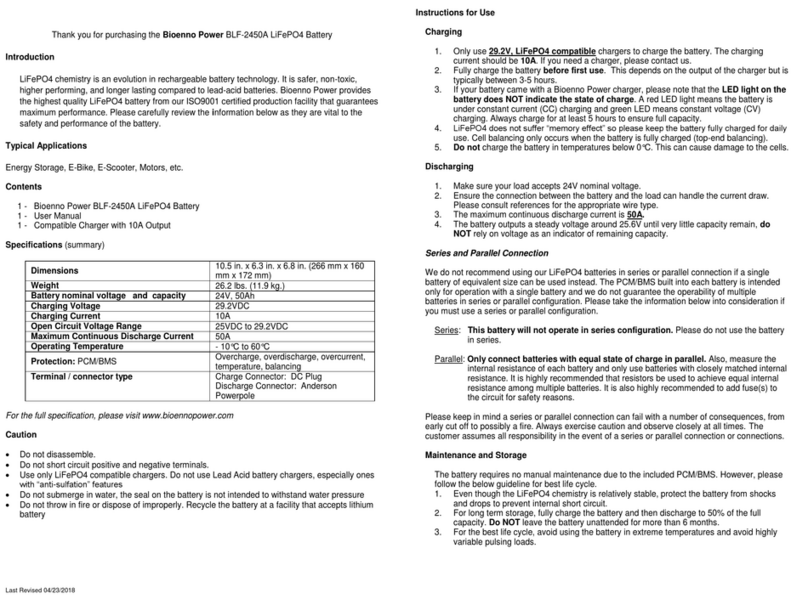
Bioenno Power
Bioenno Power BLF-2450A user manual

Gates Underwater Products
Gates Underwater Products MINI LF Setup, use and care guide
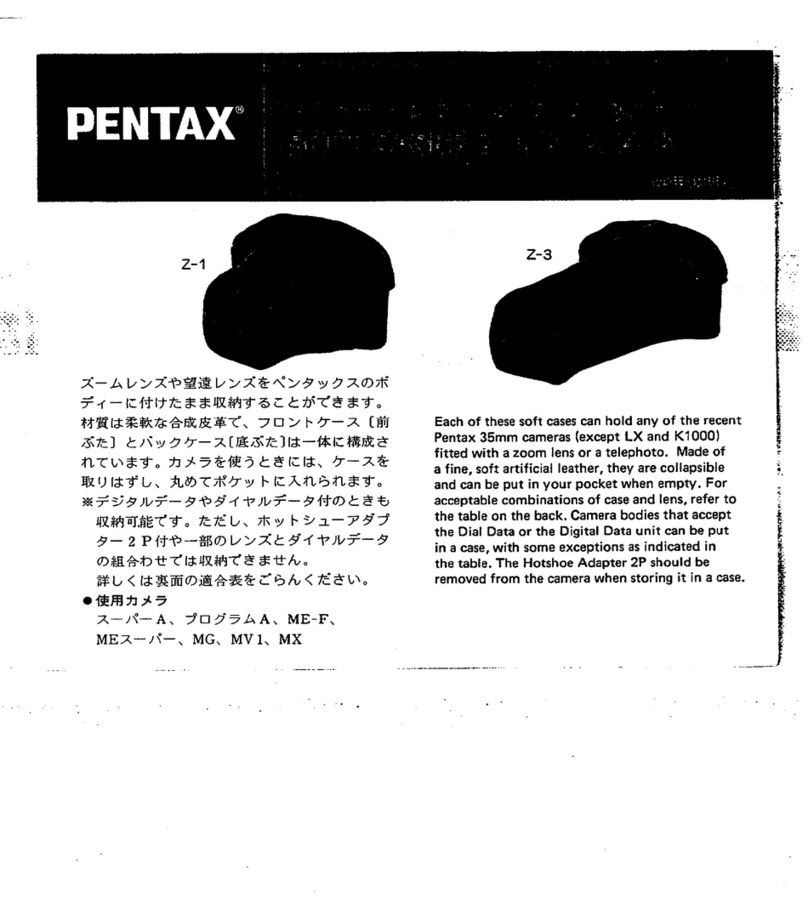
Pentax
Pentax Z-1 Interchangeable Focusing Screens Specifications
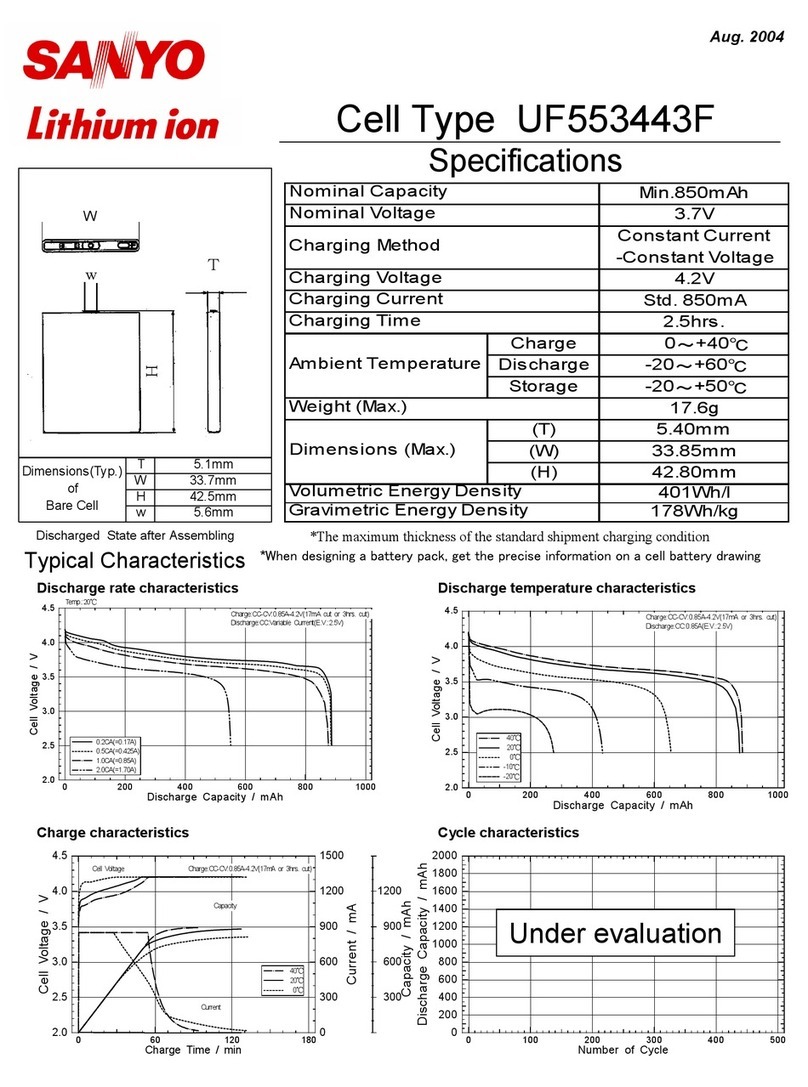
Sanyo
Sanyo UF553443F Specifications
